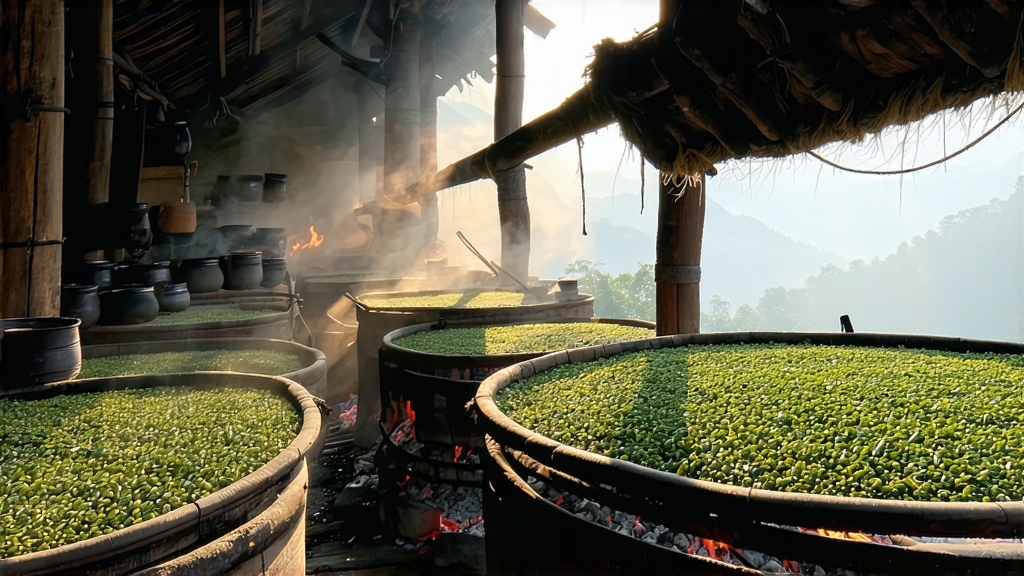
Lapsang Souchong—known in China as Zhengshan Xiaozhong—occupies a singular throne in the pantheon of black teas. It is at once the oldest recorded black tea in the world and the boldest in aroma, a sip that carries the perfume of pine resin and the memory of 17th-century trade caravans. To understand it is to trace the very birth of black tea, to walk the granite gorges of the Wuyi Mountains in northern Fujian, and to taste the moment when smoke, leaf, and time converge.
1. Origins: From Misty Gorges to Global Cups
Local legend places the accidental birth of Lapsang Souchong around 1568, late in the Ming dynasty. A passing army commandeered Tongmu village, delaying the tea farmers’ usual pan-firing schedule. To save the oxidizing leaves from spoilage, the farmers rushed them over burning pine boughs. The resulting tea—dark, glossy, and laced with campfire sweetness—was an instant curiosity. Dutch traders carried it to Europe in 1604, where it became the prototype for every “bohea” (Wuyi) tea that would soon fill London coffeehouses. Catherine of Braganza’s famed passion for the leaf helped christen afternoon tea in England, and at the center of that fashion sat Lapsang Souchong, the original smoky black.
2. Terroir: Why Only Tongmu Can Birth the True Smoke
The Wuyi range is a UNESCO dual heritage site of subtropical forest and sheer cliff. Within it, the 600–1,200 m elevation of Tongmu Guan (Tongmu Pass) traps cool, humid air that slows leaf growth and concentrates amino acids. The soil is a stony cocktail of weathered tuff and granite, freely draining yet mineral-rich. Crucially, the village is too high for the common tea pest Ectropis obliqua, so pesticides are unnecessary; the tea gardens remain essentially wild, carpeted by ferns and bamboo. Only leaf picked within this 50 km² core zone may legally be sold as Zhengshan (“original mountain”) Xiaozhong. Outside it, similar techniques yield “wai Shan” (outer mountain) copies, but they lack the honeyed depth and cool pine finish that the microclimate imparts.
3. Cultivars: The Quiet Genealogy Behind the Smoke
Most Lapsang Souchong is made from a trio of Wuyi vegetative clones—Xiao Ye Zhong (small-leaf), Da Bai Ye (large white-leaf), and the rarer Aijiao Wulong (“dwarf oolong”). Each brings a different polyphenol ratio: Xiao Ye Zhong gives brisk, citrusy brightness; Da Bai Ye contributes cocoa thickness; Aijiao Wulong adds orchid nuance that survives even the smoke. Farmers often hedge-bet, blending all three in one basket so that the finished tea carries layered complexity beneath its assertive aroma.
4. Craft: The Eight Stages That Lock Campfire in a Leaf
a. Plucking: One bud, two leaves, dawn mist still on the surface.
b. Withering: Bamboo trays set above pinewood embers in the upper loft of the three-story factory. Warm air (28–30 °C) drifts upward for 6–8 h; the leaf loses 60 % moisture and absorbs the first whisper of resin.
c. Rolling: 40 min on a cast-iron plate; cell walls rupture, catechins meet enzymes.
d. Oxidation: Leaves rest in rattan baskets inside a humid room (24 °C, 85 % RH). Color shifts from jade to copper; a malty note emerges.
e. Pan-firing: Quick 220 °C tumble for 3 min halts oxidation, sets the sugars.
f. Rolling again: Tighter twists, readying the leaf for its smoky baptism.
g. Smoking: The signature step. Pinewood and resin-rich pine roots smolder at 80–90 °C in an earthen floor pit; a bamboo sieve rack sits 1.5 m above. For traditional Lapsang, the leaf bathes in this cool smoke in 20 min cycles over 6–8 h, absorbing phenols such as guaiacol and syringol. The modern “unsmoked” or “fruit-sweet” version skips this stage, but con